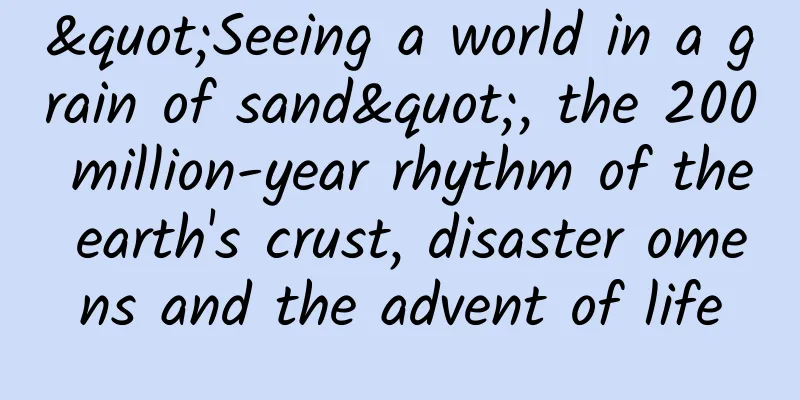"Seeing a world in a grain of sand", the 200 million-year rhythm of the earth's crust, disaster omens and the advent of life

|
William Blake, the first important romantic poet in Britain, wrote at the beginning of his poem: "Seeing a world in a grain of sand". This state of mind is not only a humanistic romance, but also carries scientific principles. Even the most inconspicuous grains of sand contain the truth of the world. In the past, people thought about the structure of our planet itself by understanding mineral grains thinner than a human hair and then inferring the chemical processes that formed them. Now, scientists have taken that focus to a whole new level - linking tiny crystalline grains to Earth's position in the context of the Milky Way galaxy. Looking into the universe Thinking on a larger scale, astrophysicists try to understand our place in the universe. They use the laws of physics to create models that describe the orbits of celestial bodies. Although we may think of Earth's surface as being shaped by processes within the planet, the planet is undoubtedly influenced by its cosmic environment - this includes periodic changes in Earth's orbit, variations in the Sun's energy, gamma-ray bursts, and of course meteorite impacts. We only need to look at the pockmarked face of the Moon to be reminded of meteorites. Indeed, recent scientific work has pointed to the importance of meteorite impacts in the formation of Earth's continental crust, especially when the Earth was young (for example, some argue that there is evidence that giant meteorites created Earth's continents). A swirl of blue and white glowing stars against a dark background, our Milky Way is thought to be similar to other barred spiral galaxies such as NGC 4394 The rhythm of Earth's crustal production Many rocks on Earth are formed from molten or semi-molten magma. These magmas come either directly from the mantle - the solid, slow-flowing layer beneath Earth's crust - or from the reheating of pre-existing, older crust. As liquid magma cools, it eventually freezes into solid rock. Through the cooling process of magma crystallization, mineral grains "grow" out, which can capture elements such as uranium, which decay over time and create a precise "stopwatch" to record their age. Not only that, the crystals also capture other elements that can trace the composition of their parent magma, just as we use a surname to trace a person's family lineage. With these two pieces of information — age and composition — scientists can reconstruct a timeline of Earth's crust. Next, its dominant frequency can be decoded using a mathematical trick called a Fourier transform - a tool that essentially decodes the frequency of an event, like, for example, what ingredients are in a cake. Our results from this method suggest that the crust of the early Earth had a rhythmicity of about 200 million years. Our Place in the Universe Scientists have discovered that there is another similar rhythm. The solar system and the four spiral arms of the Milky Way all revolve around the supermassive black hole at the center of the Milky Way, but of course, they move at different speeds. Glowing image of a spiral galaxy with blue arms and a pale golden center The spiral arms have an orbital speed of 210 kilometers per second, while the Sun's speed is 240 kilometers per second, meaning that our Solar System is "surfing" on the galaxy's spiral arms, moving in and out. The result of this model is that our solar system enters the spiral arms of the Milky Way every 200 million years. Therefore, scientists have concluded that there seems to be a possible connection between the time when the Earth's crust was formed and the time it orbits the spiral arms of the Milky Way. Verification In the distant regions of our solar system, a cloud of icy and rocky debris known as the Oort Cloud is thought to orbit our sun. As the Solar System periodically moves into the spiral arms of the Milky Way, interactions between it and the Oort Cloud move material out of the cloud and closer to the inner Solar System. Some of this material may even strike the Earth. Earth is hit relatively frequently by rocky bodies from the asteroid belt, at an average speed of 15 kilometers per second, but comets ejected from the Oort cloud arrive much faster, at an average of 52 kilometers per second. Scientists believe that these periodic high-energy impacts are traceable evidence - comet impacts cause the mantle to decompress and melt, and the elements are preserved in tiny mineral grains that can be traced as a record of the Earth's crust. This molten rock, rich in light elements such as silicon, aluminum, sodium and potassium, effectively floats on top of the denser mantle. While there are many other ways to create continental crust, it's likely that impacts created the crustal "seeds" of our planet early on. Later geologic processes created magma that attached itself to these early seeds. A harbinger of doom, or a gardener of life on Earth? The continental crust is crucial in most of the Earth's natural cycles - it interacts with water and oxygen to form new weathering products and carries most metals and biogenic carbon. Large meteorite impacts are catastrophic events that could wipe out life. Yet at the same time, they are likely key to the development of the continental crust on which we depend. With the recent passage of interstellar asteroids through the solar system, some even believe they are transporting life between universes. How did life arrive on this planet? No one is sure. Drive to the suburbs, look up at the sky on a clear night, and be mesmerized by the stars. Then look down at your feet and feel the mineral particles, rocks, and even the crust of the entire continent. All of this is amazing and is connected by a very grand galactic rhythm. Heaven and earth are not kind, and treat all things as straw dogs. All the great things we care about are insignificant. When you are alive, do your best and leave the rest to fate. Relax your mind. Source: Cosmic Decoding |
<<: It changed color and also changed gender...
>>: Wen Xiaogang: What is a quantum bit? | The Door to Wonders
Recommend
How much does it cost to develop your own app? WeChat Mini Program Development Solution
The arrival of mini programs , a new portal on th...
Cash loan product operation routines and operation system construction!
Recently, I was tasked to study the product opera...
When we see it everywhere, we know spring has really come.
Audit expert: Li Guangwang Director of the Natura...
After refuting the relationship rumors, Zhang Ming En appeared in Hu Bingqing's residential area and left immediately when he saw the candid photos!
On June 23, Zhang Ming'en was photographed ag...
Quickly develop your own WeChat applet in two days?
Why should you learn mini program development? Wh...
The flame of geology is constantly burning, and the geological spirit is passed down from generation to generation - the geological life of "Volcano Academician" Liu Jiaqi
He embodies the hard-working spirit, innovative s...
Unique in China! Swallowtail butterfly that looks like a "big-eyed alien" when young, first appeared in Jiangxi!
In the colorful world of butterflies, there is a ...
Community operation: community hierarchical management and operation model! (With gameplay)
In 2019, the concept that everyone talked about t...
Technology Morning News丨The "14th Five-Year Plan" for the development of intelligent manufacturing was released; Israel began the fourth dose of new crown vaccine vaccination experiment
【Today’s cover】 The "second nine" is ap...
Look! There are "white mushrooms" on the ceiling of the subway station...
Have you ever noticed white objects that look lik...
The Panoramic Effect: How Seeing Earth from Space Changes You
NASA astronaut Bruce McCandless II "floating...
What are the commonly used indicators for SEM data analysis? These are the key points to focus on!
During the promotion, there are a lot of data rep...
Marketing strategy insights for 2021
Today I will share with you a report on marketing...
It can be used to build warships and bring plants back to life...
END Tadpole Musical Notation original article, pl...
5 Steps to Improve Your App Store Product Description!
Like moving house or getting married, launching a...









